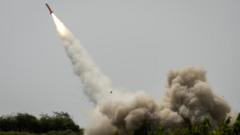The U.S. Space Force, operating from Buckley Space Force Base, provides critical missile warning and tracking capabilities, demonstrating its growing role in modern military strategy, especially amid rising global threats.**
Space Force Guardians: Inside the Nerve Center of U.S. Missile Tracking Operations**

Space Force Guardians: Inside the Nerve Center of U.S. Missile Tracking Operations**
A rare glimpse into the U.S. Space Force's operations reveals how Guardians monitor missile launches worldwide and prepare for potential conflicts in space.**
In an unprecedented exposé, the BBC has gained exclusive access to the U.S. Space Force's missile warning and tracking operations at Buckley Space Force Base, Colorado. Here, a highly trained group known as Guardians work around the clock to track missile launches across the globe, facilitating immediate responses to threats.
Inside the command center, Guardians monitor gigantic screens displaying real-time data from a fleet of military satellites. During a recent drill, as the commanding officer shouted, "Launch Yemen!" the response of "Copy, launch Yemen" echoed through the room, highlighting the precision and diligence of these operatives.
Colonel Ann Hughes described the tension during a recent live missile test when Iran fired missiles towards U.S. forces in Qatar, emphasizing their successful defense of the base. The Guardians’ ability to track these threats played a pivotal role in protecting U.S. personnel.
The budget for the U.S. missile defense initiative, dubbed the Golden Dome, is poised to receive $175 billion as part of an ambitious program inspired by Israel’s Iron Dome. This development reflects the increasing threats posed by adversaries such as China and Russia, who have made significant advances in missile technology, including hypersonic capabilities.
General David Miller, leading the U.S. Space Operations Command, pointed out the necessity of adapting to these threats, advocating for space-based interceptors to effectively counter the velocity and maneuverability of modern missiles.
Moreover, the burgeoning presence of approximately 12,000 satellites in orbit is projected to soar to 60,000 within the decade, underscoring the importance of intelligence, surveillance, and reconnaissance in an escalating conflict scenario. Colonel Phoenix Hauser articulated the need for readiness, stating, “We’re already sparring in space,” as adversarial engagements become increasingly sophisticated.
As the U.S. Space Force evolves, it is also shifting toward potential offensive capabilities, reflecting a proactive approach to maintain space superiority. This was evident during the recent Operation Midnight Hammer against Iran, showcasing their critical role in modern air operations and their capacity to adapt to jamming and other electronic warfare tactics.
Colonel Angelo Fernandez, commander of Delta 3, detailed the capabilities of their mobile satellite dishes, which are instrumental in both offensive and defensive strategies, highlighting the need for flexibility in operations.
In summary, the U.S. Space Force is firmly establishing itself as an essential component of the U.S. military apparatus, with General Miller affirming, “The entire U.S. military is dependent on space superiority.” This recognition of space as a warfighting domain reflects the transforming landscape of military engagement and underscores the imperative for continued advancements in the realm of aerospace defense. As the landscape intensifies, the message remains clear: "When the U.S. military gets focused on something - God help you!"



















